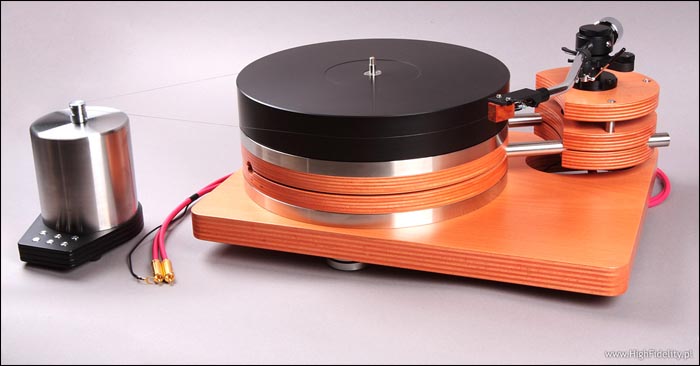|
This review page is supported in part by the sponsors whose ad banners are displayed below
|
|||||||||||||||
 |
|||||||||||||||
 |
|||||||||||||||
 |
|||||||||||||||
This review first appeared in the June 2009 issue of hi-end hifi magazine High Fidelity of Poland. You can also read this review of the Dr. Feickert Analogue Twin in its original Polish version. We publish its English translation in a mutual syndication arrangement with publisher Wojciech Pacula. As is customary for our own reviews, the writer's signature at review's end shows an e-mail address should you have questions or wish to send feedback. All images contained in this review are the property of High Fidelity. - Ed. Reviewer: Wojciech Pacula Review system: Go here Review component retail: 22.500 zł | €5.000 |
|||||||||||||||
 |
|||||||||||||||
|
This image opens to full size in a new window
"Twin. Form meets function!" That's how begins the description of this turntable by Christian Feickert, owner and executive of the Dr. Feickert Analogue company. The company motto is precision meets form, musicality meets precision. Not bad even for such an experienced analog maven as Feickert. Already known for tools like the fantastic (I've used one for two years) Universal Protractor for adjusting tonearm and cartridge settings and the advanced Feickert Adjust+ Tool software, he showed off his beloved Twin turntable 'child' at the Polish Audio Show 2007. Presented as a prototype, it attracted attention and provoked many positive comments for neither being typical in sound nor shape. Its body is composed of many constrained layers. As Feickert states, one of the main goals for his design was immunity to vibrations - including those from loudspeakers. Those vibrations must be converted into heat by mechanical absorption i.e. damping. He calls his approach MARC for Mechanical Anti Resonant Circuit. |
|||||||||||||||
|
| |||||||||||||||
|
It is sufficient to look at photos of this turntable to appreciate what this is all about. Its main part is a round plinth made from five layers of different materials: 17mm stainless steel on the bottom, then 19mm plywood, then another layer of 19mm plywood, then 17mm steel again and finally a very thick platter from a special POM polymer cut from one single block. Feickert stresses that CNC machines allow for a precision of 1/100mm in all dimensions. In this one-arm version, the whole assembly is mounted to a rectangular sub-chassis plinth made from 30mm plywood. Between the two layers of plywood mounts the movable tone arm base on two steel struts to accommodate any kind of tonearm up to 12". The motor is placed separately. At first torque was transferred by rubber belt but for the review, I received a string-driven unit. It is a bit louder but has different qualities from rubber. We get somewhat lower vibration damping properties but motor shaft and platter are better coupled for superior speed stability (the motor is controlled by a quartz-stabilized processor). |
|||||||||||||||
 |
|||||||||||||||
|
The turntable was supplied with one of the most affordable tone arms I've seen, the previously reviewed 10.5" Jelco oil-damped S shape. This is an inexpensive but really nice arm with a somewhat sweet and smooth sound. To complete the setup I received the Benz Micro Wood SL cartridge and that's what I tested. But because I did not know two of the variables -- the turntable and cartridge -- I reviewed the Twin also with other cartridges at my disposal which I knew better, the Sumiko Palo Santos Presentation, Koetsu Rosewood Signature and Denon DL-103SA and DL-103R. For a long-term reference I used the Dynavector Karat 23R, with which I have reviewed all the turntables over the last five years. The phono stages were no chopped liver either. I mainly used the brilliant RCM Audio Sensor Prelude IC but for comparison also drafted into service the Accuphase C-27, Aaron Phono Module and RIAA section of the Ayon Polaris II. It turned out that this turntable was quite prone to external vibrations (this is a rigid affair) and despite being placed on the splendid Base table I have relied on for some time, it profited much from being placing on an additional GroundIt DeLuxe 1 Pro-Ject platform (in a lead-filled version no longer manufactured as RoHS demanded Pro-Ject change the filler). This was possible because the turntable feet sit quite close to the motor. |
|||||||||||||||
|
| |||||||||||||||
|
Sound The sound of the system – this became a test of the whole system -- was incredibly exciting. Mr. Adamek, distributor for three mentioned companies, had the same opinion. I cannot deny that the excitement I talk about derived directly from the live and dynamic character of the system. Because I used a few other cartridges (Sumiko Palo Santos Presentation, Koetsu Rosewood Signature, Denon DL-103SA), I will even say how this can be attributed equally to the cartridge and the turntable with tone arms. Together, those elements amplify this tendency and erect a whole new world. The Sumiko for example has a much more resolved treble and deeper stage but lacks some saturation in the bass. The Denon on the other hand combined the juiciness of the Benz with the balance of the Sumiko whilst being a tad inferior to the others in all aspects. The Benz added a kind of turbo boost to everything. This wasn't even about underlining anything since the Twin in general is a well-balanced device. The emphasis is added on top. This may sound a bit enigmatic (I hope it doesn't) but is how it sounds. |
|||||||||||||||
 |
|||||||||||||||
 |
|||||||||||||||
 |
|||||||||||||||